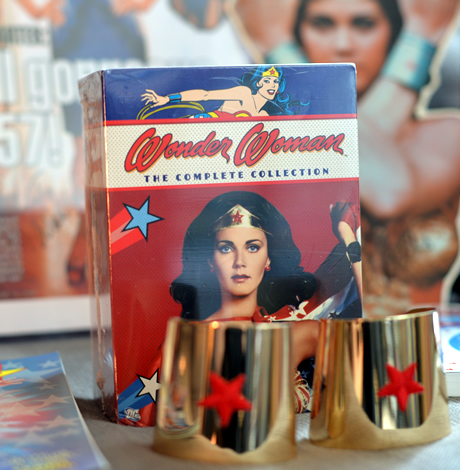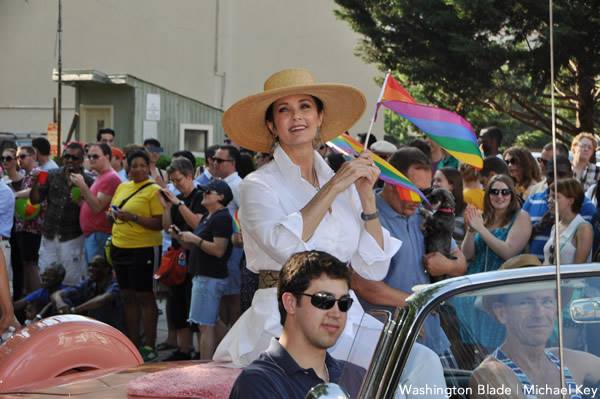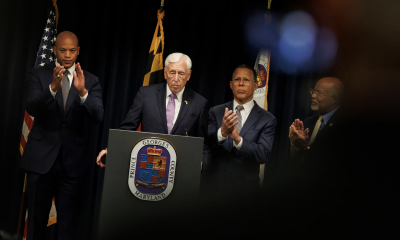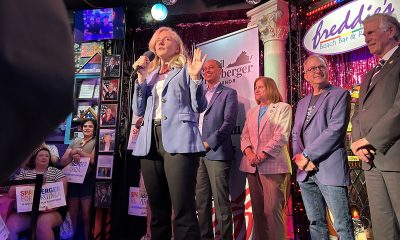a&e features
Wonder Woman’s heart is key to film’s success
The Amazon princess finally comes to the big screen


Gal Gadot as Wonder Woman with Henry Cavill as Superman and Ben Affleck as Batman in ‘Batman v. Superman: Dawn of Justice.’ The film opens March 25. (Photo courtesy Warner Bros.)
Wonder Woman has finally made it to the big screen.
The Amazon princess, who debuted in comic book form in 1941, makes her silver screen debut in “Batman v. Superman: Dawn of Justice,” the estimated $250-million spectacle from director Zack Snyder with Henry Cavill reprising his role as Superman, Ben Affleck debuting as Batman and Gal Gadot (“The Fast and the Furious”) as Wonder Woman.
The movie, which opens March 25 on an estimated 30,000 screens in 61 markets around the globe, is part of the D.C. Extended Universe series that launched with “Man of Steel,” a 2013 Superman reboot. “Suicide Squad,” featuring the D.C. Comics anti-hero team, is slated for an August release. Wonder Woman will finally get her own film with an eponymous release slated for June 2017 in which Gadot will star.
For many Generation X gays, the 1975-1979 TV show “Wonder Woman” starring Lynda Carter, who has enjoyed decades of adoration because of the role, is beyond iconic. She performs her concert “Long-Legged Woman” at the Kennedy Center at 7 p.m. on April 2.
Carter does not have cameos in either “Dawn of Justice” or next year’s film and has focused on her singing in recent years. A resident of D.C. suburb Potomac, Md., she has appeared at LGBT events such as AIDS Walk Washington in 2010 and the Capital Pride parade in 2013, where she was grand marshal. She performs annually at the Kennedy Center and has earned acclaim for songs she recorded for the video game “Fallout 4.”

Lynda Carter was grand marshal in the Capital Pride parade in 2013. She says she understands filmmakers wanting their own platform for the new films. (Washington Blade file photo by Michael Key)
But for many, she’ll always be known as Wonder Woman. Her performance was so indelible that merchandise featuring her likeness continues to be churned out with items such as the “Wonder Woman ’77” comic series, a Hallmark ornament of her as the character and more.
She told superfan Mike Pingel, author of “The Q Guide to Wonder Woman” (2008) and “Channel Surfing: Wonder Woman” (2012), in a Frontiers interview published last week that she’s honored by the attention.
“It’s a thrill to have my Wonder Woman image resurrected after all these years,” she said. “In life, you carry around these memories. Then you meet people who share their memories and you end up experiencing it all over again through their eyes. It’s great to have a big resurgence of relevance, not just being in the past but something happening right now.”
So if the character is so perennially popular, why did it take so long to bring her to the silver screen when male superhero films have been made about even lesser-known characters like “Iron Man” (2008), “Jonah Hex” (2010), “Thor: the Dark World” (2013) and more? The Wonder Woman movie has languished in development limbo since the mid-‘90s. A 2011 pilot for a possible NBC series was not picked up. The CW abandoned another TV project in 2014.

Lynda Carter with author Mike Pingel. (Photo courtesy Pingel)
“Honestly I think it could be that they just didn’t know what to do with her,” says Pingel, who’s gay and is now working on books about “The Bionic Woman” and “Buck Rogers in the 25th Century.”
“Hollywood is so male-dominated, sometimes I think men don’t know what to do with her. They have a woman director, though, now [Patty Jenkins] and hopefully she’ll be able to bring the heart and soul back to Wonder Woman that they had on the TV show. The show they tried in 2011 was just horrific. They didn’t understand the essence of who she was, her quality in helping the underdogs. … She was so mad and so angry and they couldn’t find the heart of the character. It wasn’t the actress’s fault. Even though she’s changed a lot in the comics, too, she’s always standing up for the rights of people who can’t do it for themselves. … That’s really the basis of why she does it — the heart, not the glory.”
Washington resident Walter Forbes says the ‘70s show and Carter are special to him because he watched the show growing up with his mother, who died of cancer in 1999. He first met Carter 10 years to the day after his mother died.
“I always saw her as kind of a mother, nurturing-type figure,” Forbes, 37, says of Carter. “When I met her, she was all that and more. Just like I’d hoped she would be.”
Forbes, who’s gay and says his boyfriend does not mind his Wonder Woman obsession, thinks finding the right level of toughness versus vulnerability was a lot of the delay.

Walter Forbes with his Wonder Woman collection. He owns replicas of Wonder Woman’s bracelets and tiara and has several photos and items signed by Lynda Carter. (Washington Blade photo by Michael Key)
“When people hear the word Amazon, most people think of Xena or almost like a Red Sonja-type of character. She’s a woman but they want her to be almost like a man. Lynda didn’t look like a man, she wasn’t built like a man, but at the same time she wasn’t too prissy or sexy or anything like that. I think a lot of the directors have wanted to take that role and turn her into something she wasn’t and they got hints from the fans that they weren’t going with that.”
He agrees with Pingel that the failed TV pilot was a good indication of how bad a bad Wonder Woman could be.
“It sucked,” he says. “They had her going around choking people, it was so violent, everybody knew her identity. I’m like, ‘OK, what is this show about? You’ve just stripped everything away.’ Even in the comic books, she was a loving person. She didn’t parade around like some barbarian. … That just wasn’t the essence of who Wonder Woman was.”
Carter said in a 2010 Blade interview that although she loved doing the role and has enjoyed the fans over the years, she’s moved on.
“I really love her and I really think she’s great and I particularly love the idea of her,” Carter said. “There’s so many things I like about it, but I’m busy living my life now, so I don’t think about it a lot. It’s a little like something really outstanding in your life that everybody talks about and that is wonderful and you loved doing it … but you’re busy doing other things so you really only think about it when somebody else brings it up.”
Despite fan speculation, Carter told Pingel a cameo didn’t happen because of scheduling conflicts.
“I had some nice conversations with Patty Jenkins, and we couldn’t get my schedule and their schedule to meet up. It didn’t work out, but I wish them well. Understandably they want a platform that is uniquely their own. I believe it’s an homage to the original in regards to the heart of the character. That is what matters.”

Wonder Woman memorabilia (Washington Blade photo by Michael Key)
Forbes says it would have been an insult if Carter had been offered just a brief appearance.
“I don’t want to see her in just some walk-by role,” Forbes says. “Like Lynda Carter just happens to be in Starbucks or something. I think that’s kinda tacky. Like when Lou Ferrigno was in one of the Hulk movies and he was a security guard or something. I was like, ‘Are you serious? He brought this character to life and now he’s at the front desk?’ … If all they gave her was a walk-by role, it wouldn’t be worth her time. It would be an insult.”
Forbes says even if Wonder Woman only has a small role in “Dawn of Justice” — as of press time, the extent of her part is largely unknown — and her own film bombs, it will not diminish what Carter accomplished.
“I’ll definitely see it and support it and I’m open to giving Gal Gadot a chance to feel the role,” he says. “I’m just glad to see this character back. … The fans need to give it a chance, too. Already, online people are saying, ‘Oh, they changed the uniform, it’s too dark, it looks like Xena,’ and so on. I mean, come on, give it a chance. The uniform changed in the comic books, why wouldn’t they change it for the movie? … I’m excited about this new franchise.”

A 2015 Wonder Woman Christmas tree ornament in Lynda Carter’s likeness could be found at Hallmark. (Washington Blade photo by Joey DiGuglielmo)
a&e features
Queer highlights of the 2026 Critics Choice Awards: Aunt Gladys, that ‘Heated Rivalry’ shoutout and more
Amy Madigan’s win in the supporting actress category puts her in serious contention to win the Oscar for ‘Weapons’

From Chelsea Handler shouting out Heated Rivalry in her opening monologue to Amy Madigan proving that horror performances can (and should) be taken seriously, the Critics Choice Awards provided plenty of iconic moments for queer movie fans to celebrate on the long road to Oscar night.
Handler kicked off the ceremony by recapping the biggest moments in pop culture last year, from Wicked: For Good to Sinners. She also made room to joke about the surprise hit TV sensation on everyone’s minds: “Shoutout to Heated Rivalry. Everyone loves it! Gay men love it, women love it, straight men who say they aren’t gay but work out at Equinox love it!”
The back-to-back wins for Jacob Elordi in Frankenstein and Amy Madigan in Weapons are notable, given the horror bias that awards voters typically have. Aunt Gladys instantly became a pop culture phenomenon within the LGBTQ+ community when Zach Cregger’s hit horror comedy released in August, but the thought that Madigan could be a serious awards contender for such a fun, out-there performance seemed improbable to most months ago. Now, considering the sheer amount of critics’ attention she’s received over the past month, there’s no denying she’s in the running for the Oscar.
“I really wasn’t expecting all of this because I thought people would like the movie, and I thought people would dig Gladys, but you love Gladys! I mean, it’s crazy,” Madigan said during her acceptance speech. “I get [sent] makeup tutorials and paintings. I even got one weird thing about how she’s a sex icon also, which I didn’t go too deep into that one.”
Over on the TV side, Rhea Seehorn won in the incredibly competitive best actress in a drama series category for her acclaimed performance as Carol in Pluribus, beating out the likes of Emmy winner Britt Lower for Severance, Carrie Coon for The White Lotus, and Bella Ramsey for The Last of Us. Pluribus, which was created by Breaking Bad’s showrunner Vince Gilligan, has been celebrated by audiences for its rich exploration of queer trauma and conversion therapy.
Jean Smart was Hack’s only win of the night, as Hannah Einbinder couldn’t repeat her Emmy victory in the supporting actress in a comedy series category against Janelle James, who nabbed a trophy for Abbott Elementary. Hacks lost the best comedy series award to The Studio, as it did at the Emmys in September. And in the limited series category, Erin Doherty repeated her Emmy success in supporting actress, joining in yet another Adolescence awards sweep.
As Oscar fans speculate on what these Critics Choice wins mean for future ceremonies, we have next week’s Golden Globes ceremony to look forward to on Jan. 11.
a&e features
Looking back at the 10 biggest A&E stories of 2025
‘Wicked,’ Lady Gaga’s new era, ‘Sexy’ Bailey and more

Although 2025 was a year marked by countless attacks on trans rights and political setbacks, the year also saw brilliant queer artists continuing to create art. From Cannes and Sundance Award winners now vying for Oscar consideration to pop icons entering new stages of their careers, queer people persevered to tell their stories through different media.
With the state of the world so uncertain, perhaps there’s no more vital time to celebrate our wins, as seen through some of this year’s top pop culture moments. While there’s no collection of 10 stories that fully encompass “the most important” news, here are some events that got the gays going:
10. ‘Mysterious Gaze of the Flamingo’ wins big at Cannes

The Cannes Film Festival has become a crucial start for films hoping to make their way to the Oscars, and first-time director Diego Céspedes won the top Un Certain Regard prize for his intimate western “The Mysterious Gaze of the Flamingo.” The film is set in the ‘80s and is intended as an allegory for the AIDS epidemic. Seeing a film that unpacks vital queer history win one of the most coveted awards at Cannes has been a huge point of pride in the independent filmmaking community.
Since the film bowed at Cannes, it has been selected as Chile’s Oscar entry in the Best International Feature race. Speaking with The Blade during the film’s AFI Fest run in October, Céspedes said: At first, I was kind of scared to have this campaign position in the times that we’re living [in] here. But at the same time, I think the Oscars mean a huge platform — a huge platform for art and politics.”
9. ‘The Last of Us’ returns for an even gayer season 2
While the first season of The Last of Us gave us one of TV’s most heartbreaking queer love stories in the episode “Long, Long Time,” Season 2 doubled down on its commitment to queer storytelling with the blossoming relationship between Ellie (Bella Ramsey) and Dina (Isabela Merced). The show expanded on the pair’s relationship in the original video game, making it perhaps the central dynamic to the entire season. That unfortunately came with more homophobic backlash on the internet, but those who checked out all the episodes saw a tender relationship form amid the show’s post-apocalyptic, often violent backdrop. For their performance, Ramsey was once again nominated for an Emmy, but Merced deserved just as much awards attention.
8. ‘Emilia Pérez’ sparks controversy
Jacques Audiard’s genre-bending trans musical “Emilia Pérez” proved to be an awards season juggernaut this time last year, winning the Golden Globe for Best Musical/Comedy. But when the lead star Karla Sofia Gascón’s racist, sexist, and homophobic old tweets resurfaced, the film’s Oscar campaign became a tough sell, especially after Netflix had tried so hard to sell Emilia Pérez as the “progressive” film to vote for. Mind you, the film had already received significant backlash from LGBTQ+ audiences and the Mexican community for its stereotypical and reductive portrayals, but the Gascón controversy made what was originally just social media backlash impossible to ignore. The only person who seemed to come out of the whole debacle unscathed was Zoe Saldaña, who won the Oscar for Best Supporting Actress over Ariana Grande.
7. ‘Sorry, Baby’ establishes Eva Victor as major talent
Back in January at the Sundance Film Festival, Eva Victor (known by many for her brand of sketch comedy) premiered their directorial debut “Sorry, Baby” to rave reviews, even winning the Waldo Salt Screening Award. Victor shadowed Jane Schoenbrun on the set of “I Saw the TV Glow,” and seeing Victor come into their own and establish such a strong voice immediately made them one of independent cinema’s most exciting new voices. A memorable scene in the film sees the main character, Agnes (played by Victor), struggling to check a box for male or female, just one example of how naturally queerness is woven into the fabric of the story.
Most recently, Victor was nominated for a Golden Globe for her performance in the film, and she’s represented in a category alongside Jennifer Lawrence (“Die My Love”), Jessie Buckley (“Hamnet”), Julia Roberts (“After the Hunt”), Renate Reinsve (“Sentimental Value”) and Tessa Thompson (“Hedda”). The film also received four Independent Spirit Award nominations overall.
6. Paul Reubens comes out in posthumous doc

While Paul Reubens never publicly came out as gay before passing away in 2023, the two-part documentary “Pee-wee as Himself” premiered back in May on HBO Max, giving the legendary comedian a chance to posthumously open up to the world. Directed by Matt Wolf, the documentary explores how Reubens found his alter ego Pee-Wee Herman and why he kept his private life private.
The documentary won an Emmy in the Outstanding Documentary or Nonfiction Special category and remains one of the most critically acclaimed titles of the year with a 100% Rotten Tomatoes score. Also worth noting, the National Geographic documentary Sally told the posthumous coming out story of Sally Ride through the help of her long-time partner, Tam O’Shaughnessy.
5. Lady Gaga releases ‘Mayhem’
Lady Gaga entered a new phase of her musical career with the release of Mayhem, her seventh album to date. From the frenzy-inducing pop hit Abracadabra to the memorable Bruno Mars duet featured on “Die With a Smile,” seeing Gaga return to her roots and make an album for the most die-hard of fans was especially rewarding after the underwhelming film releases of “House of Gucci” and “Joker: Folie à Deux.” Gaga has been touring with The Mayhem Ball since July, her first arena tour since 2018. She even extended her tour into 2026 with more North American dates, so the party isn’t stopping anytime soon. And Gaga is even set to make an appearance next May in “The Devil Wears Prada 2.”
4. Cynthia Erivo, Ariana Grande perform at the Oscars

While “Wicked: For Good” didn’t quite reach the heights of the first film, we will forever have Cynthia Erivo and Ariana Grande’s breathtaking live performance that opened the 97th Academy Awards. The pair sang a rendition of “Over the Rainbow,” “Home,” and “Defying Gravity,” paying proper homage to the original 1939 “Wizard of Oz.” Even non-Wicked fans can’t deny how magical and brilliantly staged this performance was. With both Erivo and Grande up for acting Oscars last year, they’re hoping to repeat success and make history with consecutive nominations. Either way, let’s hope there’s another live performance in the making, especially with two new original songs (The Girl in the Bubble and No Place Like Home) in the mix.
3. Indya Moore speaks out against Ryan Murphy
Indya Moore has consistently used social media as a platform for activism, and in September, posted a 30-minute Instagram live speaking out against “Pose” co-creator Ryan Murphy. Moore claimed that Murphy wasn’t being a true activist for trans people. “Ryan Murphy, we need you to do more. You need to address the racism, the violence, and the targeting of people on your productions, Ryan Murphy. You do need to make sure trans people are paid equally. Yes, Janet did the right thing,” Moore said. Murphy was also back in the headlines this year for the critically panned “All’s Fair” and the controversial “Monster: The Ed Gein Story” starring Laurie Metcalf and Charlie Hunnam.
2. Cole Escola wins Tony for Best Leading Actor
Few pop culture moments this year brought us together more than Cole Escola winning a Tony award for “Oh, Mary!” the Broadway show they created, wrote and starred in (we love a triple threat!) Escola made history by becoming the first nonbinary person to win a Tony in the leading actor category, and seeing them excitedly rush to the stage wearing a Bernadette Peters-inspired gown instantly became a viral social media moment.
The cherry on top of Escola’s major moment is the recent news that they are writing a Miss Piggy movie with Jennifer Lawrence and Emma Stone producing — news that also broke the internet for the better. We cannot wait!
1. Jonathan Bailey makes gay history as ‘Sexiest Man Alive’

The same year as his on-screen roles in blockbusters “Jurassic World Rebirth” and “Wicked: For Good,” Jonathan Bailey made history as the first openly gay man to be named People magazine’s “Sexiest Man Alive.” The fact that it took 40 years for an openly gay man to earn the title is a signifier of how far we still have to go with queer representation, and seeing Bailey celebrated is just one small step in the right direction.
“There’s so many people that want to do brilliant stuff who feel like they can’t,” he told PEOPLE, “and I know the LGBT sector is under immense threat at the moment. So it’s been amazing to meet people who have the expertise and see potential that I could have only dreamed of.” In 2024, Bailey founded the charity titled The Shameless Fund, which raises money for LGBTQ+ organizations.
a&e features
Your guide to D.C.’s queer New Year’s Eve parties
Ring in 2026 with drag, leather, Champagne, and more

With Christmas in the rear view mirror, we can turn our attention to ringing in a much-anticipated New Year with a slew of local LGBTQ parties. Here’s what’s on tap.
Pitchers
This spacious Adams Morgan bar is hosting the “Pitchers’ Perfect New Year’s Eve.” There will be a midnight Champagne toast, the ball drop on the big screens, and no cover, all night long. The bar doesn’t close until 4 a.m., and the kitchen will be open late (though not until close). All five floors will be open for the party, and party favors are promised.
Trade
D.C.’s hottest bar/club combo is leaning into the Shark motif with its NYE party, “Feeding Frenzy.” The party is a “glitterati-infused Naughty-cal New Year’s Even in the Shark Tank, where the boats are churning and the sharks are circling.” Trade also boasts no cover charge, with doors opening at 5 p.m. and the aforementioned Shark Tank opening at 9 p.m.. Four DJs will be spread across the two spaces; midnight hostess is played by Vagenesis and the two sea sirens sensuously calling are Anathema and Justin Williams.
Number Nine
While Trade will have two DJs as part of one party, Number Nine will host two separate parties, one on each floor. The first floor is classic Number Nine, a more casual-style event with the countdown on TVs and a Champagne midnight toast. There will be no cover and doors open at 5 p.m. Upstairs will be hosted by Capital Sapphics for its second annual NYE gathering. Tickets (about $50) include a midnight Champagne toast, curated drink menu, sapphic DJ set by Rijak, and tarot readings by Yooji.
Crush
Crush will kick off NYE with a free drag bingo at 8 p.m. for the early birds. Post-bingo, there will be a cover for the rest of the evening, featuring two DJs. The cover ($20 limited pre-sale that includes line skip until 11 p.m.; $25 at the door after 9 p.m.) includes one free N/A or Crush, a Champagne toast, and party favors (“the legal kind”). More details on Eventbrite.
Bunker
This subterranean lair is hosting a NYE party entitled “Frosted & Fur: Aspen After Dark New Year’s Eve Celebration.” Arriety from Rupaul Season 15 is set to host, with International DJ Alex Lo. Doors open at 9 p.m. and close at 3 p.m.; there is a midnight Champagne toast. Cover is $25, plus an optional $99 all-you-can-drink package.
District Eagle
This leather-focused bar is hosting “Bulge” for its NYE party. Each District Eagle floor will have its own music and vibe. Doors run from 7 p.m.-3 a.m. and cover is $15. There will be a Champagne toast at midnight, as well as drink specials during the event.
Kiki, Shakiki
Kiki and its new sister bar program Shakiki (in the old Shakers space) will have the same type of party on New Year’s Eve. Both bars open their doors at 5 p.m. and stay open until closing time. Both will offer a Champagne toast at midnight. At Kiki, DJ Vodkatrina will play; at Shakiki, it’ll be DJ Alex Love. Kiki keeps the party going on New Year’s Day, opening at 2 p.m., to celebrate Kiki’s fourth anniversary. There will be a drag show at 6 p.m. and an early 2000s dance party 4-8 p.m.
Spark
This bar and its new menu of alcoholic and twin N/A drinks will host a NYE party with music by DJ Emerald Fox. Given this menu, there will be a complimentary toast at midnight, guests can choose either sparkling wine with or without alcohol. No cover, but Spark is also offering optional wristbands at the door for $35 open bar 11 p.m.-1 a.m. (mid-shelf liquor & all NA drinks).
-

 District of Columbia4 days ago
District of Columbia4 days agoTwo pioneering gay journalists to speak at Thursday event
-

 Colombia4 days ago
Colombia4 days agoBlade travels to Colombia after U.S. forces seize Maduro in Venezuela
-

 a&e features4 days ago
a&e features4 days agoQueer highlights of the 2026 Critics Choice Awards: Aunt Gladys, that ‘Heated Rivalry’ shoutout and more
-

 Virginia4 days ago
Virginia4 days agoLGBTQ groups to join Spanberger inaugural parade




















